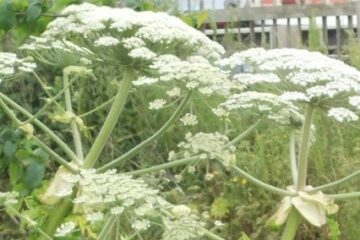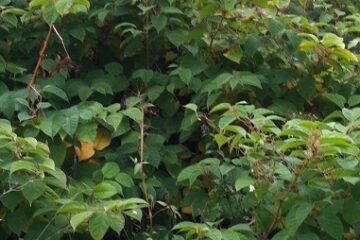A question which has come up a few times recently is ‘But why do I need to treat invasive plant species?’. There are several reasons but the short answer is ‘to avoid eventually breaking the law’ which is the almost inevitable consequence of inaction.
The crucial word in that answer is eventually, it’s not illegal to have an invasive plant species growing on your land. Your neighbours probably won’t be happy about it but the authorities won’t force you to take any action to deal with plants within your site boundary, with the possible exception of Giant Hogweed causing a public health risk where they may serve you with an enforcement notice.
However, invasive plant species are largely considered to be a problem because of their voracious growth patterns and lack of natural controls and plants don’t care about a fence or imaginary line on the ground defining ownership. So without any significantly limiting factors they will just keep growing. Japanese Knotweed spreads vegetatively and in particular is famed for the speed and extent of it’s growth so even a small stand will spread off-site eventually if left unchecked. Both Himalayan Balsam and Giant Hogweed produce prodigious amounts of seeds which can be spread by wind, water or animals so if any of these plants make it to your site boundary or worse a water course running through your site they will soon be spreading from your property onto someone else’s land.
If you allow any of the invasive plant species on the restricted list to spread from your land then you’re in breach of the Wildlife and Countryside Act 1981 (England and Wales) or Natural Environment (Scotland) Act 2011. This legislation makes it a criminal offence to cause or allow these plants to spread from your land.
The other reasons are less dramatic but just as pressing. The presence of Japanese Knotweed makes it almost impossible to get a mortgage for that property so you’ll be stuck with that bit of land gradually getting less valuable with nobody able to buy it even if they wanted to. Any decent surveyor will spot it so realistically you’ll find it very difficult to just sell the land and pass the problem to someone else.
The sooner you start doing something about these plants the less costly it will be because small stands are always easier and cheaper to treat or remove. With some plants like Giant Hogweed if you get in early enough you can completely remove the risk of it spreading because immature plants don’t produce seeds!
Finally, and without wanting to sound preachy about this you have a responsibility to properly manage your land. Giant Hogweed represents a health risk and Japanese Knotweed has been known to damage building foundations affecting their stability.
2021
Soil remediation guide
Approaching soil remediation without any prior knowledge can be difficult and uncomfortable at times, especially when it can potentially be very costly. This free eBook will help you understand the whats, the whys and the hows of soil remediation in the simplest terms.







Leave a Reply